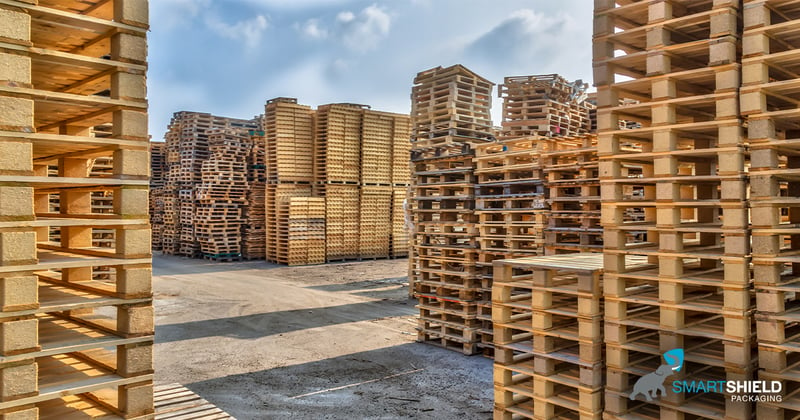Heat treating is a process that prevents harmful insects and other contaminants from damaging your pallets and inventory. Heat treated pallets are also more durable and certified for use in international trade.
What is a heat treated pallet?
Heat treated pallets, also known as HT Pallets, undergo a process of sterilizing the wood to eliminate insects, remove moisture, and prevent contamination. The process of heat treatment involves exposing pallets to a minimum core temperature of 56°C (132.8°F) for at least 30 minutes in a CFIA-approved Heat Treatment facility.
3 Benefits of heat treated pallets
1. Eliminates insects, fungi and contaminants
Heat treating pallets will kill insects, larvae, and bacteria living or growing in wooden packaging materials. In contrast, standard pallets may have insect eggs and infectious diseases living within the wood, which can spread to or infect other pallets and local trees. With heat treated pallets, the wood is heated to a temperature that will prevent and eliminate harmful infestations.
2. Certified for international trade
Regulations for wooden packaging materials differ from country to country. However, many countries have adopted a set of standards to ensure imported products and materials are free from contaminations and infestations.
At SmartShield Packaging, we provide custom crating and softwood pallets that use a two-way, heat-treated process. As an HT-certified company, we can track every piece of lumber going through our manufacturing to ensure you enjoy total peace of mind
3. Lasts longer than standard pallets
Heat treated pallets are exposed to high temperatures, removing moisture from the wood and allowing them to last longer than standard pallets. Unlike HT pallets, standard pallets can rot and decay from moisture – reducing their lifespan and reusability. HT Pallets are significantly more durable and cost-effective as they can better withstand the demands of frequent pallet use while resisting damage due to moisture. From a shipping standpoint, heat treated pallets are also much lighter than standard pallets, allowing you to save money on shipping costs.
Do your pallets need to be heat treated?
For pallets that will never be exported and do not carry food-related products, heat treatment or fumigation is not required. Only pallets (or lumber, crates, and other forms of wood packaging) that will be exported to other countries or carry food-grade products need to be heat treated.
All food-grade pallets must be heat treated
If your business requires pallets to ship or store food goods, heat treatment ensures that:
- Wood is safe for contact with food
- Contaminates are eliminated from wood surfaces
- HT pallets meet industry specifications for food transportation
- Pallets will not damage products or have exposed splinters
International shipments require HT stamped pallets
Exports with wood packaging are regulated under an international standard, ISPM 15, to prevent invasive species from being introduced to other countries. This standard requires wood pallets to be heat treated and marked to indicate that they have been treated prior to shipment.
What countries require heat treated pallets?
Every country is different in terms of import requirements. However, the following countries have all implemented ISPM 15 regulations when it comes to imports of wood packaging materials.
Fig. 1 – Countries requiring ISPM-15 (USDA)
|
Algeria
|
Costa Rica
|
Jamaica
|
Nicaragua
|
Syria
|
|
Argentina
|
Cuba
|
Japan
|
Nigeria
|
Taiwan
|
|
Australia
|
Dominican Republic
|
Jordan
|
Norway
|
Thailand
|
|
Belarus
|
Ecuador
|
Kenya
|
Oman
|
Trinidad & Tobago
|
|
Bosnia
|
Egypt
|
Korea
|
Paraguay
|
Tunisia
|
|
Brazil
|
European Union
|
Lebanon
|
Peru
|
Turkey
|
|
Cameroon
|
Guatemala
|
Malaysia
|
Philippines
|
Ukraine
|
|
Canada
|
Honduras
|
Malta
|
Seychelles
|
United Kingdom
|
|
Chile
|
India
|
Mexico
|
South Africa
|
United States
|
|
China
|
Indonesia
|
Montenegro
|
Sri Lanka
|
Venezuela
|
|
Columbia
|
Israel
|
New Zealand
|
Switzerland
|
Vietnam
|
Exporting to the above countries requires an official stamp placed on the pallet to signify any wood packaging, such as wooden pallets, complies with ISPM 15 regulations. The HT stamp verifies that all wood packaging materials have been processed by heat treatment (HT) or fumigated with methyl bromide.
Why go with heat treated pallets?
Heat treated pallets are the smart choice to protect your products — for local and international shipments. They also last longer than standard wood pallets and can be used multiple times without worry of decay from moisture. Plus, heat treatment removes moisture from wood pallets and allows you to cut unnecessary costs and shipping fees.
Save money and protect your products with SmartShield. Our custom packaging designers work 1-on-1 with you to create the right way to safeguard your products, including heat treated pallets for shipments or storage. Contact us for a custom quote today!

